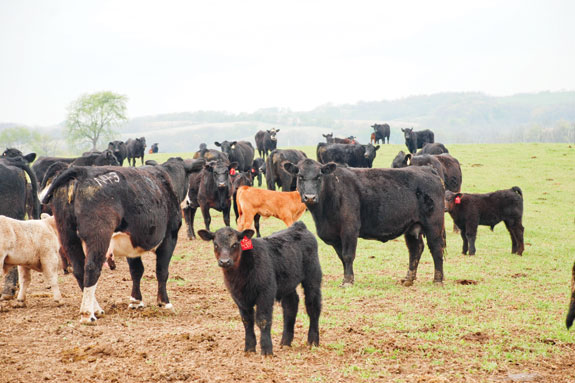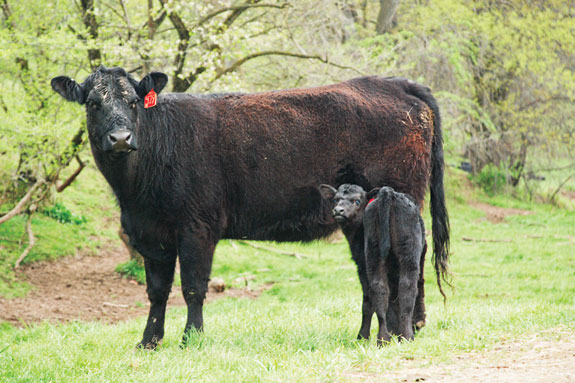The problem caused added expenses, required additional employee hours, added death losses within the calf crop and set calves back in terms of performance.
Today, a strategic newborn calf management program helps this Midwest herd avoid scours and enhance calf health.
With proper cow and calf management, this Monroe, Wisconsin, operation has achieved a 95 percent live calf rate from birth to weaning.
Brad Bader, owner and farm manager for Carrousel Farms’ beef unit, now acknowledges preparation and prevention as two key drivers behind positive calving seasons.
Healthy calves are a vital asset to this herd, so scours, E. coli or coronavirus issues are prevented from the start.
“Our strategy is to keep the cows and calves healthy from day one,” Bader says. “If we can keep calf problems from starting, we won’t have problems in the long run. We’ve found that to be a much better strategy – in terms of both production and finances – than trying to fix issues later. Healthy newborn calves do better down the road.”

Most calves from the herd are marketed as club calves for the show ring or breeding stock throughout the country.
Calves not utilized for those options are fed onsite at the Carrousel Farms feedlot.
“Our calves need to work in any of these industry settings,” Bader says. “Along with genetics, management plays a big role in the calves’ ability to perform.”
Healthy newborn calves begin with properly conditioned cows. Realizing the importance of a healthy herd, the 700 cows at Carrousel Farms are monitored closely for body condition scores (BCS).
High nutrient levels are provided through the entire gestation period so cows can provide nutrients to their calves in utero rather than working to rebuild body condition. Nutritional changes are made by group to promote consistent BCS scores.
“Healthy cows have more potential to produce healthy calves,” Bader says. “Keeping the cows in proper condition helps the calves tackle issues once they’re on the ground.”
Calving season also occurs by group. The managers at Carrousel Farms stagger spring calving by breeding first-calf heifers prior to older cows.

First-calf heifers begin calving on February 15, with older cows beginning lactation on March 1.
The two-week delay allows employees on the operation to focus on the younger heifers, helping them to transition into the herd smoothly.
First-calf heifers all calve indoors to allow close surveillance.
The farm also has a capacity to move groups of older cows inside if Wisconsin weather becomes problematic.
Bader explains that the transition from gestation to lactation is a critical time for the entire herd. To keep stress on each cow at a minimum, an employee is assigned to witness the majority of the births on the farm.
“Someone is with the cows every three hours, day and night. That employee watches for minor problems so they can stop them before they become big problems,” he says, adding that cows are monitored for dystocia issues while calves are observed to ensure adequate colostrum consumption within their first 12 hours of life.
“We make sure that each calf gets up and nurses as soon as possible,” Bader says. “The first protection through colostrum makes a very big difference in the life of the calf.”
If the calf does not naturally begin to nurse outside, the pair is brought indoors and the calf is encouraged to nurse.
Frozen colostrum from local dairies is also kept on hand for cows that are unable to produce the necessary four quarts of quality colostrum.
Supplemental colostrum is collected from cows in their third or greater lactation from Johnes-free herds to promote high quality.
“Protecting the calf immediately is the best thing we can do for our calf crop, so we make sure each calf is fully protected,” Bader says.
Regardless of the method of colostrum consumption, each calf at Carrousel Farms also receives a USDA-approved antibody product in either bolus or paste form.
The easy-to-administer product was added to the calving season toolbox during the scours issue in the early 1990s.
“We had a minor flare-up of scours,” Bader remembers. “Treating the calves was costly and time-consuming, and it also set the calves back in terms of performance.”
That year’s calf crop required considerable additional resources to meet their potential.
The following year, Bader’s team provided each calf with a USDA-approved antibody product and continues to use the product on all newborn calves.
“Each calf receives a bolus within their first few hours of life,” Bader says. “Our employees saw the added step as a very easy transition because the product is simple to administer, and it created less work through the growing season. That year, our scours were basically nonexistent.”
The success of that season has been repeated for the past decade at Carrousel Farms. The combination of herd health, scheduled calving and immediate calf protection helps calves receive the best start possible so they can perform to their full potential.
“When our calves are healthy from day one, they do better in the show ring, the pasture or the feedlot,” Bader says. “The small investment made on day one is worth it many times over in the long run.” ![]()
Jeff Hoffelt is a marketing associate at Filament Marketing, LLC
PHOTOS
TOP: By monitoring cows during the calving process and ensuring that each calf receives immediate protection following birth, Brad Bader, owner of Carrousel Farms, has secured a 95 percent live calf rate throughout the past decade.
MIDDLE: Carrousel Farms in Monroe, Wisconsin, implements a strategic newborn calf management program each spring.
BOTTOM: The 700 cows at Carrousel Farms are monitored closely for body condition scores to maintain high nutrient levels passed to calves in utero and post-calving. Photos courtesy of Filament Marketing.







